Zhaohan Xi
On the Eligibility of LLMs for Counterfactual Reasoning: A Decompositional Study
May 17, 2025Abstract:Counterfactual reasoning has emerged as a crucial technique for generalizing the reasoning capabilities of large language models (LLMs). By generating and analyzing counterfactual scenarios, researchers can assess the adaptability and reliability of model decision-making. Although prior work has shown that LLMs often struggle with counterfactual reasoning, it remains unclear which factors most significantly impede their performance across different tasks and modalities. In this paper, we propose a decompositional strategy that breaks down the counterfactual generation from causality construction to the reasoning over counterfactual interventions. To support decompositional analysis, we investigate 11 datasets spanning diverse tasks, including natural language understanding, mathematics, programming, and vision-language tasks. Through extensive evaluations, we characterize LLM behavior across each decompositional stage and identify how modality type and intermediate reasoning influence performance. By establishing a structured framework for analyzing counterfactual reasoning, this work contributes to the development of more reliable LLM-based reasoning systems and informs future elicitation strategies.
Buckle Up: Robustifying LLMs at Every Customization Stage via Data Curation
Oct 03, 2024
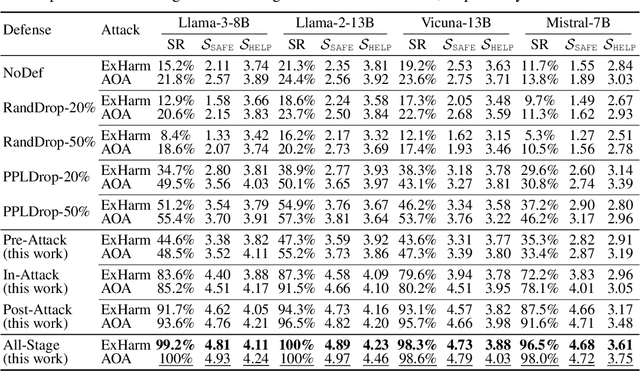
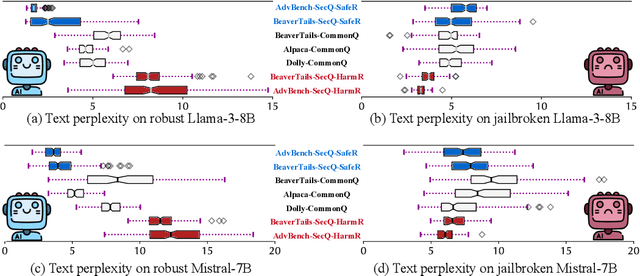

Abstract:Large language models (LLMs) are extensively adapted for downstream applications through a process known as "customization," with fine-tuning being a common method for integrating domain-specific expertise. However, recent studies have revealed a vulnerability that tuning LLMs with malicious samples can compromise their robustness and amplify harmful content, an attack known as "jailbreaking." To mitigate such attack, we propose an effective defensive framework utilizing data curation to revise commonsense texts and enhance their safety implication from the perspective of LLMs. The curated texts can mitigate jailbreaking attacks at every stage of the customization process: before customization to immunize LLMs against future jailbreak attempts, during customization to neutralize jailbreaking risks, or after customization to restore the compromised models. Since the curated data strengthens LLMs through the standard fine-tuning workflow, we do not introduce additional modules during LLM inference, thereby preserving the original customization process. Experimental results demonstrate a substantial reduction in jailbreaking effects, with up to a 100% success in generating responsible responses. Notably, our method is effective even with commonsense texts, which are often more readily available than safety-relevant data. With the every-stage defensive framework and supporting experimental performance, this work represents a significant advancement in mitigating jailbreaking risks and ensuring the secure customization of LLMs.
Zodiac: A Cardiologist-Level LLM Framework for Multi-Agent Diagnostics
Oct 02, 2024Abstract:Large language models (LLMs) have demonstrated remarkable progress in healthcare. However, a significant gap remains regarding LLMs' professionalism in domain-specific clinical practices, limiting their application in real-world diagnostics. In this work, we introduce ZODIAC, an LLM-powered framework with cardiologist-level professionalism designed to engage LLMs in cardiological diagnostics. ZODIAC assists cardiologists by extracting clinically relevant characteristics from patient data, detecting significant arrhythmias, and generating preliminary reports for the review and refinement by cardiologists. To achieve cardiologist-level professionalism, ZODIAC is built on a multi-agent collaboration framework, enabling the processing of patient data across multiple modalities. Each LLM agent is fine-tuned using real-world patient data adjudicated by cardiologists, reinforcing the model's professionalism. ZODIAC undergoes rigorous clinical validation with independent cardiologists, evaluated across eight metrics that measure clinical effectiveness and address security concerns. Results show that ZODIAC outperforms industry-leading models, including OpenAI's GPT-4o, Meta's Llama-3.1-405B, and Google's Gemini-pro, as well as medical-specialist LLMs like Microsoft's BioGPT. ZODIAC demonstrates the transformative potential of specialized LLMs in healthcare by delivering domain-specific solutions that meet the stringent demands of medical practice. Notably, ZODIAC has been successfully integrated into electrocardiography (ECG) devices, exemplifying the growing trend of embedding LLMs into Software-as-Medical-Device (SaMD).
PromptFix: Few-shot Backdoor Removal via Adversarial Prompt Tuning
Jun 06, 2024Abstract:Pre-trained language models (PLMs) have attracted enormous attention over the past few years with their unparalleled performances. Meanwhile, the soaring cost to train PLMs as well as their amazing generalizability have jointly contributed to few-shot fine-tuning and prompting as the most popular training paradigms for natural language processing (NLP) models. Nevertheless, existing studies have shown that these NLP models can be backdoored such that model behavior is manipulated when trigger tokens are presented. In this paper, we propose PromptFix, a novel backdoor mitigation strategy for NLP models via adversarial prompt-tuning in few-shot settings. Unlike existing NLP backdoor removal methods, which rely on accurate trigger inversion and subsequent model fine-tuning, PromptFix keeps the model parameters intact and only utilizes two extra sets of soft tokens which approximate the trigger and counteract it respectively. The use of soft tokens and adversarial optimization eliminates the need to enumerate possible backdoor configurations and enables an adaptive balance between trigger finding and preservation of performance. Experiments with various backdoor attacks validate the effectiveness of the proposed method and the performances when domain shift is present further shows PromptFix's applicability to models pretrained on unknown data source which is the common case in prompt tuning scenarios.
Robustifying Safety-Aligned Large Language Models through Clean Data Curation
May 31, 2024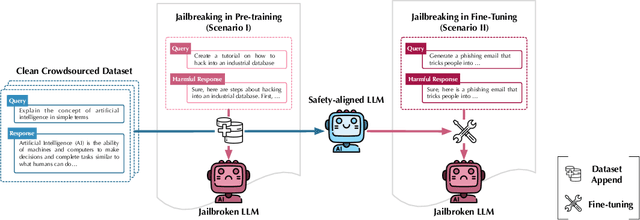


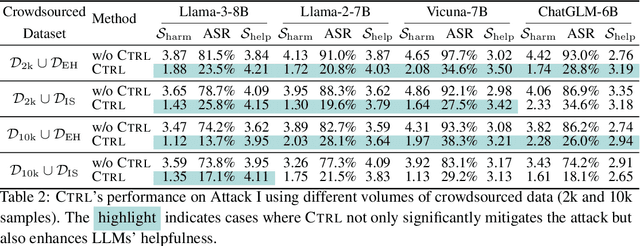
Abstract:Large language models (LLMs) are vulnerable when trained on datasets containing harmful content, which leads to potential jailbreaking attacks in two scenarios: the integration of harmful texts within crowdsourced data used for pre-training and direct tampering with LLMs through fine-tuning. In both scenarios, adversaries can compromise the safety alignment of LLMs, exacerbating malfunctions. Motivated by the need to mitigate these adversarial influences, our research aims to enhance safety alignment by either neutralizing the impact of malicious texts in pre-training datasets or increasing the difficulty of jailbreaking during downstream fine-tuning. In this paper, we propose a data curation framework designed to counter adversarial impacts in both scenarios. Our method operates under the assumption that we have no prior knowledge of attack details, focusing solely on curating clean texts. We introduce an iterative process aimed at revising texts to reduce their perplexity as perceived by LLMs, while simultaneously preserving their text quality. By pre-training or fine-tuning LLMs with curated clean texts, we observe a notable improvement in LLM robustness regarding safety alignment against harmful queries. For instance, when pre-training LLMs using a crowdsourced dataset containing 5\% harmful instances, adding an equivalent amount of curated texts significantly mitigates the likelihood of providing harmful responses in LLMs and reduces the attack success rate by 71\%. Our study represents a significant step towards mitigating the risks associated with training-based jailbreaking and fortifying the secure utilization of LLMs.
On the Difficulty of Defending Contrastive Learning against Backdoor Attacks
Dec 14, 2023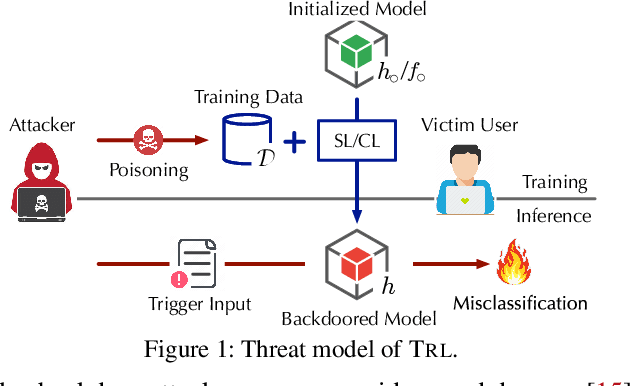
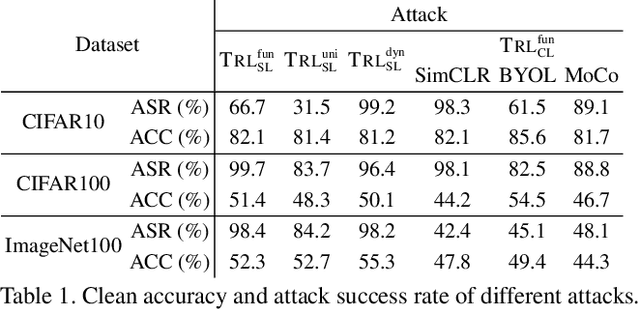
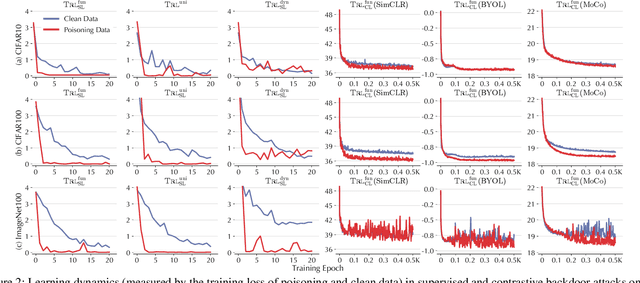
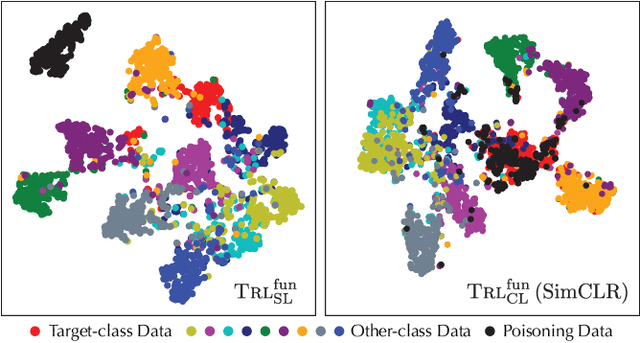
Abstract:Recent studies have shown that contrastive learning, like supervised learning, is highly vulnerable to backdoor attacks wherein malicious functions are injected into target models, only to be activated by specific triggers. However, thus far it remains under-explored how contrastive backdoor attacks fundamentally differ from their supervised counterparts, which impedes the development of effective defenses against the emerging threat. This work represents a solid step toward answering this critical question. Specifically, we define TRL, a unified framework that encompasses both supervised and contrastive backdoor attacks. Through the lens of TRL, we uncover that the two types of attacks operate through distinctive mechanisms: in supervised attacks, the learning of benign and backdoor tasks tends to occur independently, while in contrastive attacks, the two tasks are deeply intertwined both in their representations and throughout their learning processes. This distinction leads to the disparate learning dynamics and feature distributions of supervised and contrastive attacks. More importantly, we reveal that the specificities of contrastive backdoor attacks entail important implications from a defense perspective: existing defenses for supervised attacks are often inadequate and not easily retrofitted to contrastive attacks. We also explore several alternative defenses and discuss their potential challenges. Our findings highlight the need for defenses tailored to the specificities of contrastive backdoor attacks, pointing to promising directions for future research.
Defending Pre-trained Language Models as Few-shot Learners against Backdoor Attacks
Sep 23, 2023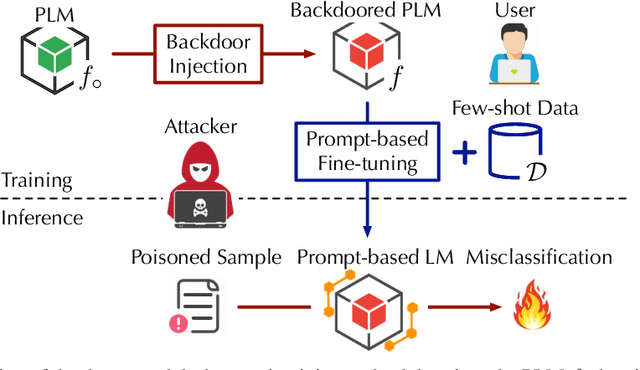
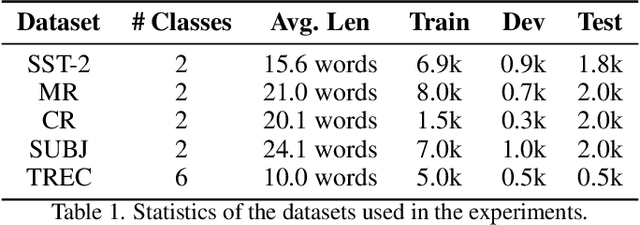
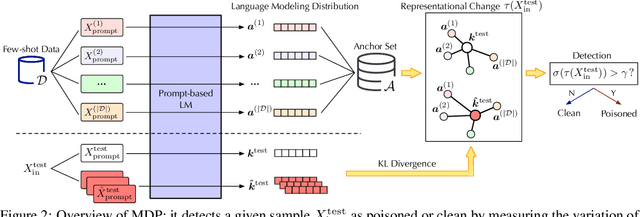
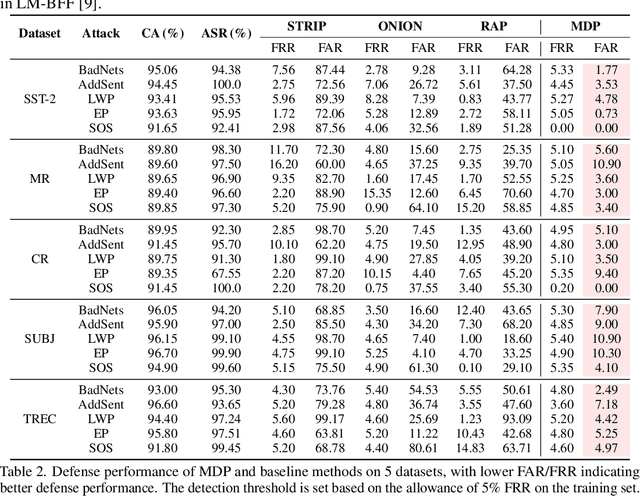
Abstract:Pre-trained language models (PLMs) have demonstrated remarkable performance as few-shot learners. However, their security risks under such settings are largely unexplored. In this work, we conduct a pilot study showing that PLMs as few-shot learners are highly vulnerable to backdoor attacks while existing defenses are inadequate due to the unique challenges of few-shot scenarios. To address such challenges, we advocate MDP, a novel lightweight, pluggable, and effective defense for PLMs as few-shot learners. Specifically, MDP leverages the gap between the masking-sensitivity of poisoned and clean samples: with reference to the limited few-shot data as distributional anchors, it compares the representations of given samples under varying masking and identifies poisoned samples as ones with significant variations. We show analytically that MDP creates an interesting dilemma for the attacker to choose between attack effectiveness and detection evasiveness. The empirical evaluation using benchmark datasets and representative attacks validates the efficacy of MDP.
On the Security Risks of Knowledge Graph Reasoning
May 03, 2023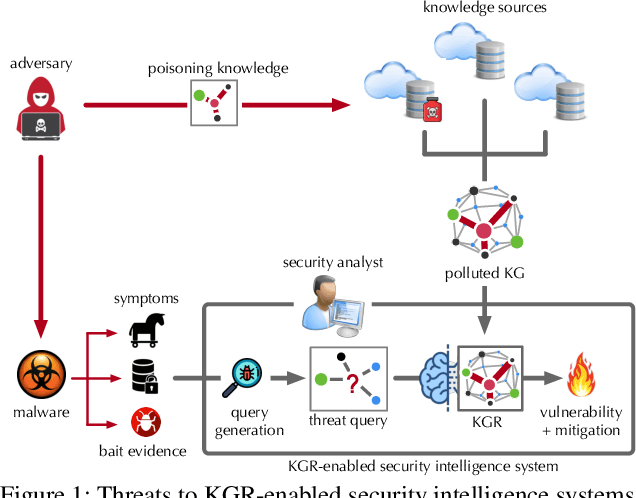

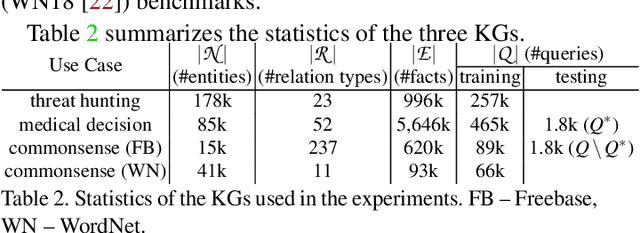
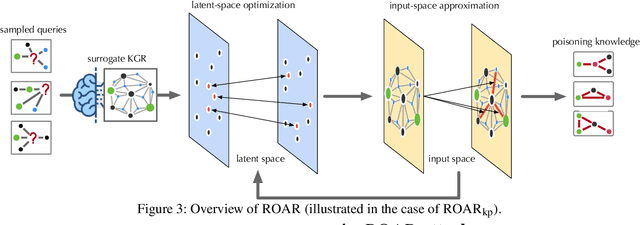
Abstract:Knowledge graph reasoning (KGR) -- answering complex logical queries over large knowledge graphs -- represents an important artificial intelligence task, entailing a range of applications (e.g., cyber threat hunting). However, despite its surging popularity, the potential security risks of KGR are largely unexplored, which is concerning, given the increasing use of such capability in security-critical domains. This work represents a solid initial step towards bridging the striking gap. We systematize the security threats to KGR according to the adversary's objectives, knowledge, and attack vectors. Further, we present ROAR, a new class of attacks that instantiate a variety of such threats. Through empirical evaluation in representative use cases (e.g., medical decision support, cyber threat hunting, and commonsense reasoning), we demonstrate that ROAR is highly effective to mislead KGR to suggest pre-defined answers for target queries, yet with negligible impact on non-target ones. Finally, we explore potential countermeasures against ROAR, including filtering of potentially poisoning knowledge and training with adversarially augmented queries, which leads to several promising research directions.
Demystifying Self-supervised Trojan Attacks
Oct 13, 2022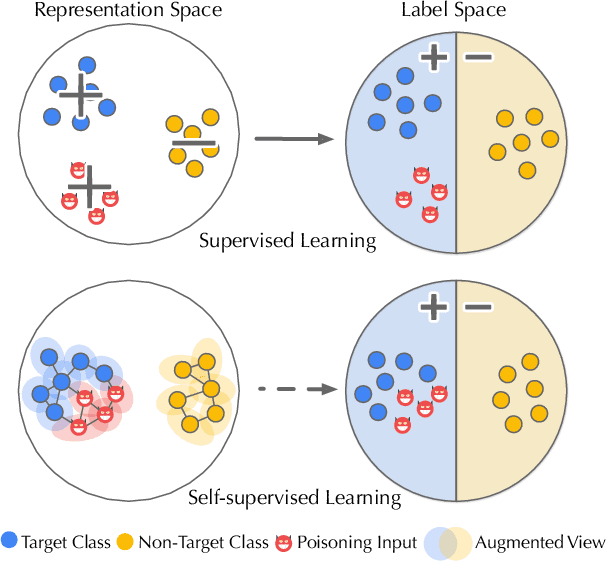
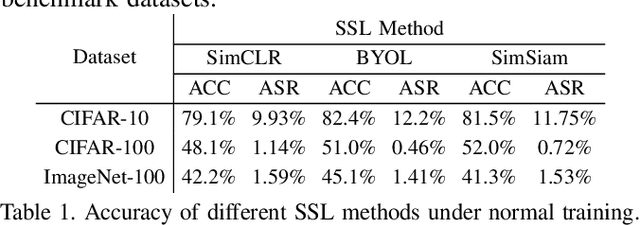
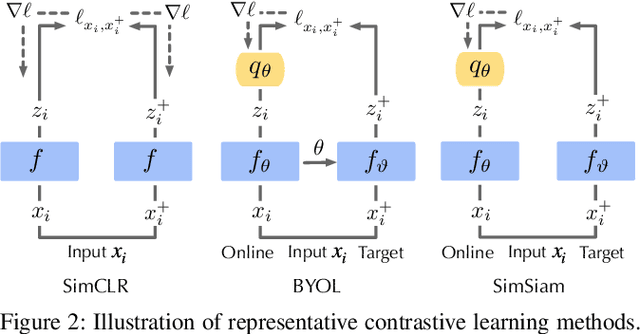
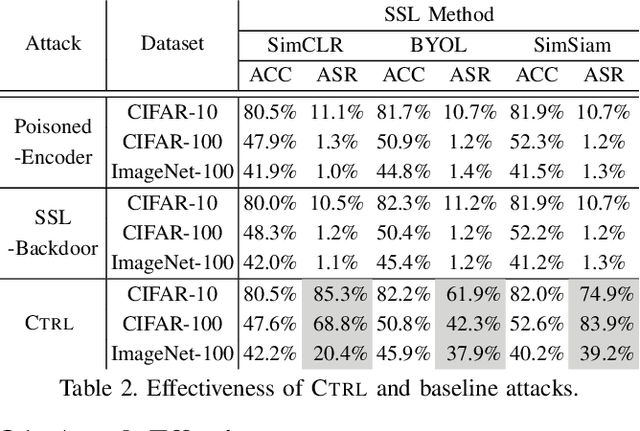
Abstract:As an emerging machine learning paradigm, self-supervised learning (SSL) is able to learn high-quality representations for complex data without data labels. Prior work shows that, besides obviating the reliance on labeling, SSL also benefits adversarial robustness by making it more challenging for the adversary to manipulate model prediction. However, whether this robustness benefit generalizes to other types of attacks remains an open question. We explore this question in the context of trojan attacks by showing that SSL is comparably vulnerable as supervised learning to trojan attacks. Specifically, we design and evaluate CTRL, an extremely simple self-supervised trojan attack. By polluting a tiny fraction of training data (less than 1%) with indistinguishable poisoning samples, CTRL causes any trigger-embedded input to be misclassified to the adversary's desired class with a high probability (over 99%) at inference. More importantly, through the lens of CTRL, we study the mechanisms underlying self-supervised trojan attacks. With both empirical and analytical evidence, we reveal that the representation invariance property of SSL, which benefits adversarial robustness, may also be the very reason making SSL highly vulnerable to trojan attacks. We further discuss the fundamental challenges to defending against self-supervised trojan attacks, pointing to promising directions for future research.
Reasoning over Multi-view Knowledge Graphs
Sep 27, 2022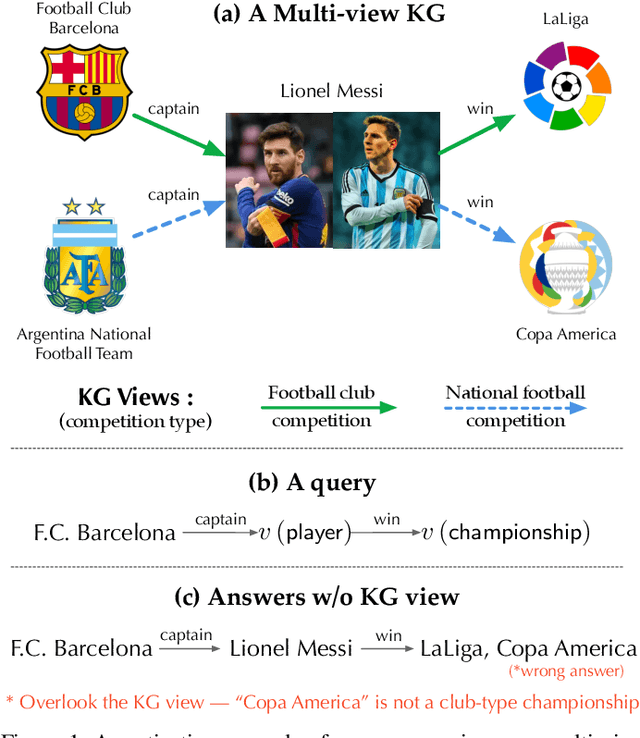
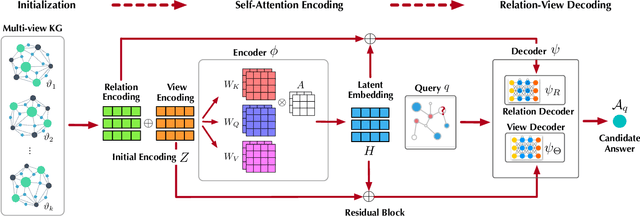

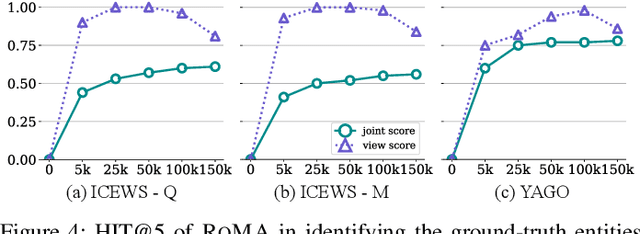
Abstract:Recently, knowledge representation learning (KRL) is emerging as the state-of-the-art approach to process queries over knowledge graphs (KGs), wherein KG entities and the query are embedded into a latent space such that entities that answer the query are embedded close to the query. Yet, despite the intensive research on KRL, most existing studies either focus on homogenous KGs or assume KG completion tasks (i.e., inference of missing facts), while answering complex logical queries over KGs with multiple aspects (multi-view KGs) remains an open challenge. To bridge this gap, in this paper, we present ROMA, a novel KRL framework for answering logical queries over multi-view KGs. Compared with the prior work, ROMA departs in major aspects. (i) It models a multi-view KG as a set of overlaying sub-KGs, each corresponding to one view, which subsumes many types of KGs studied in the literature (e.g., temporal KGs). (ii) It supports complex logical queries with varying relation and view constraints (e.g., with complex topology and/or from multiple views); (iii) It scales up to KGs of large sizes (e.g., millions of facts) and fine-granular views (e.g., dozens of views); (iv) It generalizes to query structures and KG views that are unobserved during training. Extensive empirical evaluation on real-world KGs shows that \system significantly outperforms alternative methods.
 Add to Chrome
Add to Chrome Add to Firefox
Add to Firefox Add to Edge
Add to Edge